Review: The increasing impact of activity-based protein profiling in plant science
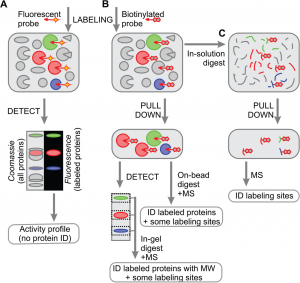 Activity-based protein profiling is a proteomics approach that involves covalently labeling reporter tags to subsets of proteins based on their active sites. Morimoto and van der Hoorn define different types of probes and the types of proteins that they bind to. Activity profiling can reveal different activity levels of closely related protein-family members, and their differential responses to pathogens or stimuli. It can also reveal differential inhibitor effects. The authors describe several useful activity probes and their targets, and show how activity-based protein profiling has already provided insights into pathogen responses and developmental processes. Plant Cell Physiol. 10.1093/pcp/pcw003 Tags: Biochemistry, Metabolism
Activity-based protein profiling is a proteomics approach that involves covalently labeling reporter tags to subsets of proteins based on their active sites. Morimoto and van der Hoorn define different types of probes and the types of proteins that they bind to. Activity profiling can reveal different activity levels of closely related protein-family members, and their differential responses to pathogens or stimuli. It can also reveal differential inhibitor effects. The authors describe several useful activity probes and their targets, and show how activity-based protein profiling has already provided insights into pathogen responses and developmental processes. Plant Cell Physiol. 10.1093/pcp/pcw003 Tags: Biochemistry, Metabolism
Review: Modifying bananas: From transgenics to organics?
 Did you know that bananas are: one of the top ten world food crops, the world’s most popular fruit, eaten in nearly every country, and an important food security crop in regions where they are grown? Did you also know that most bananas are triploid and usually sterile, making conventional breeding approaches nearly impossible? Dale et al. review the roles of bananas in our diet and challenges in their genetic improvement. The authors describe transgenic approaches as well as the more recent cisgenic approaches (using banana genes) for increased vitamin A production and resistance to Panama disease, which is caused by a fungal pathogen. Finally, the conflict between the “organic” label and more sustainable banana production is addressed. Sustainability 10.3390/su9030333 Tags: Applied Plant Biology, Genetics
Did you know that bananas are: one of the top ten world food crops, the world’s most popular fruit, eaten in nearly every country, and an important food security crop in regions where they are grown? Did you also know that most bananas are triploid and usually sterile, making conventional breeding approaches nearly impossible? Dale et al. review the roles of bananas in our diet and challenges in their genetic improvement. The authors describe transgenic approaches as well as the more recent cisgenic approaches (using banana genes) for increased vitamin A production and resistance to Panama disease, which is caused by a fungal pathogen. Finally, the conflict between the “organic” label and more sustainable banana production is addressed. Sustainability 10.3390/su9030333 Tags: Applied Plant Biology, Genetics
Review: Synthetic botany
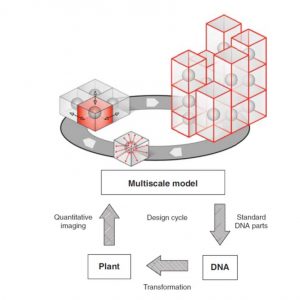 As photosynthetic autotrophs, plants have the potential to convert sunlight into a vast array of useful products: to act as little green metabolic factories. Of course, they already provide us with everything from carbohydrates and vitamins to stimulants and medicinal compounds, but with a few small tweaks they can do so much more. Boehm et al. summarize the potential and challenges of Synthetic Botany. Their perspective spans the approaches needed to edit plant genomes (nuclear and plastid), as well as the benefits of compartmentalized metabolism. The authors observe that to be successful, synthetic botany requires the adoption of engineering principles including standardized parts and cycles of design, building and testing. They conclude by describing the liverwort Marchantia polymorpha as an excellent model, intermediate in scale and complexity between microbes and angiosperms. Cold Spring Harb. Perspect. 10.1101/cshperspect.a023887 Tags: Biochemistry, Genetics, Synthetic Biology
As photosynthetic autotrophs, plants have the potential to convert sunlight into a vast array of useful products: to act as little green metabolic factories. Of course, they already provide us with everything from carbohydrates and vitamins to stimulants and medicinal compounds, but with a few small tweaks they can do so much more. Boehm et al. summarize the potential and challenges of Synthetic Botany. Their perspective spans the approaches needed to edit plant genomes (nuclear and plastid), as well as the benefits of compartmentalized metabolism. The authors observe that to be successful, synthetic botany requires the adoption of engineering principles including standardized parts and cycles of design, building and testing. They conclude by describing the liverwort Marchantia polymorpha as an excellent model, intermediate in scale and complexity between microbes and angiosperms. Cold Spring Harb. Perspect. 10.1101/cshperspect.a023887 Tags: Biochemistry, Genetics, Synthetic Biology
Review: Signaling in early maize kernel development
 The formation of a maize kernel requires growth coordination between embryo, endosperm, and surrounding maternal tissues. Key molecular actors in this coordination are hormones, sugars, peptides and transcription factors. Doll et al. review recent advances in our understanding of maize kernel development, drawing on genetic and –omics data. The authors also point out similarities and differences between seed development in Arabidopsis and maize (which has a much larger seed and a persistent endosperm). Mol. Plant 10.1016/j.molp.2017.01.008 Tags: Development, Signals and Responses
The formation of a maize kernel requires growth coordination between embryo, endosperm, and surrounding maternal tissues. Key molecular actors in this coordination are hormones, sugars, peptides and transcription factors. Doll et al. review recent advances in our understanding of maize kernel development, drawing on genetic and –omics data. The authors also point out similarities and differences between seed development in Arabidopsis and maize (which has a much larger seed and a persistent endosperm). Mol. Plant 10.1016/j.molp.2017.01.008 Tags: Development, Signals and Responses
Review: Host-microbe and microbe-microbe interactions for plant breeding ($)
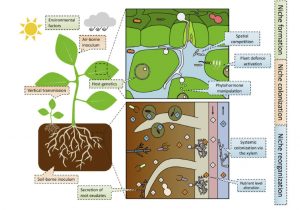 The idea that the microbes on and within an organism (the microbiota) influence an organism in positive, neutral and negative ways has been a hot topic in popular science, especially the role of the gut microbiota in human health and nutrition. Plants are similarly influenced by their microbiota, as reviewed by Kroll et al. Although there is a lot of potential for crop improvement by optimizing beneficial host-microbiota interactions, many uncertainties must be resolved before this becomes a reliable practice, largely because these interactions are so diverse and often unstable and short-lived. The authors identify four key themes for further study: environmental biology, ecology, host biology, and interorganismic interactions. Curr. Opin. Plant Biol. 10.1016/j.pbi.2017.01.004 Tags: Biotic Interactions, Genetics
The idea that the microbes on and within an organism (the microbiota) influence an organism in positive, neutral and negative ways has been a hot topic in popular science, especially the role of the gut microbiota in human health and nutrition. Plants are similarly influenced by their microbiota, as reviewed by Kroll et al. Although there is a lot of potential for crop improvement by optimizing beneficial host-microbiota interactions, many uncertainties must be resolved before this becomes a reliable practice, largely because these interactions are so diverse and often unstable and short-lived. The authors identify four key themes for further study: environmental biology, ecology, host biology, and interorganismic interactions. Curr. Opin. Plant Biol. 10.1016/j.pbi.2017.01.004 Tags: Biotic Interactions, Genetics
Review: The genomic basis of adaptation in plants ($)
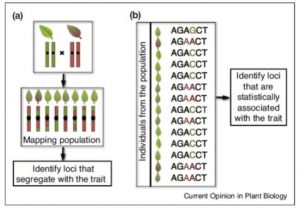 Evolution starts with molecular variation and phenotypic diversity, upon which selection acts. Flood and Hancock review the approaches used to detect adaptive evolution. The top down approach starts with the phenotype and works to identify its genomic basis; examples are quantitative trait locus (QTL) mapping or genome-wide association screening (GWAS). The bottom up approach starts with genomic polymorphisms and connects them to adaptive phenotypes, through population genomics and genomic scan approaches. Patterns of polymorphisms and linkage disequilibria can shed light on the nature of the adaptive scenario, for example whether selection involved a hard or soft sweep. As the authors describe, these approaches and models can be applied to both natural selection and adaptation during domestication. Curr. Opin. Plant Biol. 10.1016/j.pbi.2017.02.003 Tags: Evolution, Genetics, Genomics
Evolution starts with molecular variation and phenotypic diversity, upon which selection acts. Flood and Hancock review the approaches used to detect adaptive evolution. The top down approach starts with the phenotype and works to identify its genomic basis; examples are quantitative trait locus (QTL) mapping or genome-wide association screening (GWAS). The bottom up approach starts with genomic polymorphisms and connects them to adaptive phenotypes, through population genomics and genomic scan approaches. Patterns of polymorphisms and linkage disequilibria can shed light on the nature of the adaptive scenario, for example whether selection involved a hard or soft sweep. As the authors describe, these approaches and models can be applied to both natural selection and adaptation during domestication. Curr. Opin. Plant Biol. 10.1016/j.pbi.2017.02.003 Tags: Evolution, Genetics, Genomics
Research Highlight: Knocking out consumer concerns and regulator’s rules with CRISPR/Cas
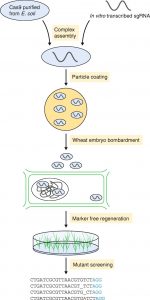 When is a genome-edited plant a GMO (and subject to GMO-restrictions)? Wolter and Puchta summarize two important papers that show that CRISPR/Cas genome editing can be achieved in wheat and rice without the introduction of foreign DNA (making these plants “not GMO”), by delivering complexes of enzyme and guide RNA. The authors conclude: “We will only be able to address challenges of the world, including ensuring sufficient food supply, if we evaluate newly developed technologies for their risk potential and their sustainability in a rational way. Hopefully, the two publications discussed here will help to achieve this goal and make the CRISPR/Cas technology more accessible for use in agriculture all over the globe.” Genome Biol. 10.1186/s13059-017-1179-1 Tags: Applied Plant Biology, Education and Outreach
When is a genome-edited plant a GMO (and subject to GMO-restrictions)? Wolter and Puchta summarize two important papers that show that CRISPR/Cas genome editing can be achieved in wheat and rice without the introduction of foreign DNA (making these plants “not GMO”), by delivering complexes of enzyme and guide RNA. The authors conclude: “We will only be able to address challenges of the world, including ensuring sufficient food supply, if we evaluate newly developed technologies for their risk potential and their sustainability in a rational way. Hopefully, the two publications discussed here will help to achieve this goal and make the CRISPR/Cas technology more accessible for use in agriculture all over the globe.” Genome Biol. 10.1186/s13059-017-1179-1 Tags: Applied Plant Biology, Education and Outreach
Technical Report: The rapid A–Ci response: photosynthesis in the phenomic era ($)
 Large-scale phenotyping efforts depend on large numbers of measurements, so the time taken for any one measurement has a big effect on the number of samples that can be processed. Stinziano et al. describe a breakthrough in the method used to identify the photosynthetic parameters Vc,max (maximum rate of Rubisco carboxylation) and Jmax (maximum rate of electron transport) from measurements of CO2 uptake (A) at different intercellular concentrations of CO2 (Ci). Remarkably, the new method, rapid A–Ci response (RACiR), produces essentially the same parameters as the conventional approach, but with the ability to screen hundreds rather than tens of plants per day. Plant Cell Environ. 10.1111/pce.12911 Tags: Bioenergetics, Genetics, Physiology
Large-scale phenotyping efforts depend on large numbers of measurements, so the time taken for any one measurement has a big effect on the number of samples that can be processed. Stinziano et al. describe a breakthrough in the method used to identify the photosynthetic parameters Vc,max (maximum rate of Rubisco carboxylation) and Jmax (maximum rate of electron transport) from measurements of CO2 uptake (A) at different intercellular concentrations of CO2 (Ci). Remarkably, the new method, rapid A–Ci response (RACiR), produces essentially the same parameters as the conventional approach, but with the ability to screen hundreds rather than tens of plants per day. Plant Cell Environ. 10.1111/pce.12911 Tags: Bioenergetics, Genetics, Physiology
ARGONAUTE10 promotes degradation of miR165/6 through SDN1 and SDN2 exonucleases
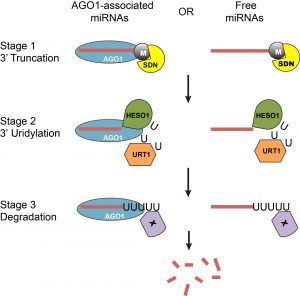 ARGONAUTE10 (AGO10) was first identified through genetic studies in the 90s; loss-of-function mutants (zwille, pinhead) show premature differentiation of the shoot apical meristem. Although the mechanism has been uncertain, AGO10 has been shown to suppress accumulation of miR165/6, which are key regulators of a large number of developmentally important transcription factors. Yu, Ji, and Le et al. propose a model for miRNA degradation, and demonstrate the contributions of members of the family of SMALL RNA DEGRADING NUCLEASES (SDNs) in miRNA degradation. They also show that when bound by AGO10, miR165/6 degradation is enhanced, thus providing a molecular mechanism for AGO10 function. PLOS Biol. 10.1371/journal.pbio.2001272 Tags: Molecular BiologyEarly evolution of the land plant circadian clock
ARGONAUTE10 (AGO10) was first identified through genetic studies in the 90s; loss-of-function mutants (zwille, pinhead) show premature differentiation of the shoot apical meristem. Although the mechanism has been uncertain, AGO10 has been shown to suppress accumulation of miR165/6, which are key regulators of a large number of developmentally important transcription factors. Yu, Ji, and Le et al. propose a model for miRNA degradation, and demonstrate the contributions of members of the family of SMALL RNA DEGRADING NUCLEASES (SDNs) in miRNA degradation. They also show that when bound by AGO10, miR165/6 degradation is enhanced, thus providing a molecular mechanism for AGO10 function. PLOS Biol. 10.1371/journal.pbio.2001272 Tags: Molecular BiologyEarly evolution of the land plant circadian clock
Early evolution of the land plant circadian clock
 Clocks in green algae have been described as simple two-gene loops, while clocks in angiosperms have evolved to complex interlocked loops. This striking jump in complexity led Linde et al. to investigate the clocks in bryophytes and charophytes to shed light on this transition. First, through the sequence analysis of bryophyte’s and charophyte’s available genomes, the authors identified several homologues to the Arabidopsis clock genes, with some differences in copy number (duplication and loss) and presence. Then, they characterized the rhythmicity and functionality of such genes in mutants of the liverwort Marchantia polymorpha, as well as expression patterns in the former and the hornwort Anthoceros agrestis. Although we still don’t know what processes these clock genes control in bryophytes and charophytes, the results suggest an early occurrence of a complex circadian network that was present before or concurrent with the colonization of land by plants. (Summary by Gaby Auge) New Phytol. doi: 10.1111/nph.14487 Tags: Botany, Evolution, Gene Regulation, Genetics
Clocks in green algae have been described as simple two-gene loops, while clocks in angiosperms have evolved to complex interlocked loops. This striking jump in complexity led Linde et al. to investigate the clocks in bryophytes and charophytes to shed light on this transition. First, through the sequence analysis of bryophyte’s and charophyte’s available genomes, the authors identified several homologues to the Arabidopsis clock genes, with some differences in copy number (duplication and loss) and presence. Then, they characterized the rhythmicity and functionality of such genes in mutants of the liverwort Marchantia polymorpha, as well as expression patterns in the former and the hornwort Anthoceros agrestis. Although we still don’t know what processes these clock genes control in bryophytes and charophytes, the results suggest an early occurrence of a complex circadian network that was present before or concurrent with the colonization of land by plants. (Summary by Gaby Auge) New Phytol. doi: 10.1111/nph.14487 Tags: Botany, Evolution, Gene Regulation, Genetics
Arabidopsis O-fucosyltransferase SPINDLY activates growth repressor DELLA ($)
 The SPINDLY (SPY) gene was identified through a genetic screen; spy mutants are abnormally tall and thin, suggesting that they are overly sensitive to gibberellins. Later, the SPY gene was shown to act downstream of GIBBEERLLIN INSENSITIVE (GAI), which is a DELLA-domain containing protein. SPY was previously identified as showing homology to O-GlcNac transferases, but this activity was not demonstrated. In this new work, Zentelli, Sui et al. show that in fact SPY is an O-fucosyltransferase, and that O-fucosylation activates DELLA-containing proteins. This paper not only solves a 20-year old mystery about the function of SPY, but also opens a new line of inquiry into O-fucosylation as a post-translational regulator. Nature Chem. Biol. 10.1038/nchembio.2320 Tags: Biochemistry, Signals and Responses
The SPINDLY (SPY) gene was identified through a genetic screen; spy mutants are abnormally tall and thin, suggesting that they are overly sensitive to gibberellins. Later, the SPY gene was shown to act downstream of GIBBEERLLIN INSENSITIVE (GAI), which is a DELLA-domain containing protein. SPY was previously identified as showing homology to O-GlcNac transferases, but this activity was not demonstrated. In this new work, Zentelli, Sui et al. show that in fact SPY is an O-fucosyltransferase, and that O-fucosylation activates DELLA-containing proteins. This paper not only solves a 20-year old mystery about the function of SPY, but also opens a new line of inquiry into O-fucosylation as a post-translational regulator. Nature Chem. Biol. 10.1038/nchembio.2320 Tags: Biochemistry, Signals and Responses
Reducing pesticide use while preserving crop productivity and profitability ($)
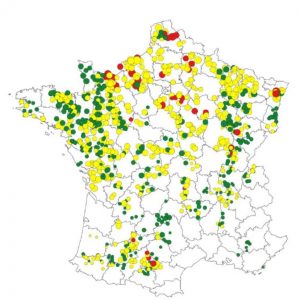 To safeguard human health and the environment, the French government has called for a nation-wide reduction in the use of pesticides (herbicides, fungicides and insecticides). Towards this end, they have been collecting pesticide usage and yield data from French farmers. Lechenet et al. explored these data to identify potential impacts of decreasing pesticide use. Their study indicates that many farms ought to be able to decrease their pesticide use with no negative impact on productivity and profitability, although this is less feasible for farms in certain regions growing certain crops. Although this study indicates the potential for lowering pesticide use, the authors point out that “the adoption of low-pesticide management strategies might be challenging for farmers… and increase the complexity of farming management”. Nature Plants 10.1038/nplants.2017.8 Tags: Applied Plant Biology, Environmental Plant Biology
To safeguard human health and the environment, the French government has called for a nation-wide reduction in the use of pesticides (herbicides, fungicides and insecticides). Towards this end, they have been collecting pesticide usage and yield data from French farmers. Lechenet et al. explored these data to identify potential impacts of decreasing pesticide use. Their study indicates that many farms ought to be able to decrease their pesticide use with no negative impact on productivity and profitability, although this is less feasible for farms in certain regions growing certain crops. Although this study indicates the potential for lowering pesticide use, the authors point out that “the adoption of low-pesticide management strategies might be challenging for farmers… and increase the complexity of farming management”. Nature Plants 10.1038/nplants.2017.8 Tags: Applied Plant Biology, Environmental Plant Biology
Stomatal immunity: Roles of MAP kinases and cytokinin
 When a pathogen is perceived, plants have the ability to induce stomatal closure to prohibit the pathogens from passing into the inner tissues; this response is known as stomatal immunity. Two new papers in The Plant Cell investigate mechanisms by which pathogen perception is transduced into stomatal closure. Su et al. 10.1105/tpc.16.00577 show that MPK3 and MKP6 and their upstream activators are necessary for stomatal closure in response to flg22 (a peptide epitope that mimics flagellin). They also show a role for malate (an osmotically active anion) metabolism in MPK3/MPK6-mediated stomatal immunity. Arnaud et al. 10.1105/tpc.16.00583 show that cytokinin signaling activates the production of reactive oxygen species through peroxidases, leading to stomatal closure. Plant Cell Tags: Biotic Interactions, Cell Biology, Signals and Responses
When a pathogen is perceived, plants have the ability to induce stomatal closure to prohibit the pathogens from passing into the inner tissues; this response is known as stomatal immunity. Two new papers in The Plant Cell investigate mechanisms by which pathogen perception is transduced into stomatal closure. Su et al. 10.1105/tpc.16.00577 show that MPK3 and MKP6 and their upstream activators are necessary for stomatal closure in response to flg22 (a peptide epitope that mimics flagellin). They also show a role for malate (an osmotically active anion) metabolism in MPK3/MPK6-mediated stomatal immunity. Arnaud et al. 10.1105/tpc.16.00583 show that cytokinin signaling activates the production of reactive oxygen species through peroxidases, leading to stomatal closure. Plant Cell Tags: Biotic Interactions, Cell Biology, Signals and Responses
OsFTIP1 is required for transport of rice flowering signal (florigen)
 Flowering at the right time of year is crucial for plant reproductive success, so in many plants the transition to reproductive growth is sensitive to daylength. In recent years, the daylength-responsive signal that moves from leaves to the shoot apical meristem, florigen (encoded by FLOWERING LOCUS T (FT) in Arabidopsis), has been identified, but questions about its transport remain. Song et al. used CRISPR/Cas to mutagenize OsFTIP1, the rice orthologue of FT-INTERACTING PROTEIN 1, demonstrating its requirement for the movement of RICE FLOWERING LOCUS T (RFT) from companion cells to sieve elements and subsequent transport to the shoot apical meristem. The authors also show that the abundance of OsFTIP1 in leaves is regulated by proteolysis. Plant Cell 10.1105/tpc.16.00728 Tags: Abiotic Interactions,
Flowering at the right time of year is crucial for plant reproductive success, so in many plants the transition to reproductive growth is sensitive to daylength. In recent years, the daylength-responsive signal that moves from leaves to the shoot apical meristem, florigen (encoded by FLOWERING LOCUS T (FT) in Arabidopsis), has been identified, but questions about its transport remain. Song et al. used CRISPR/Cas to mutagenize OsFTIP1, the rice orthologue of FT-INTERACTING PROTEIN 1, demonstrating its requirement for the movement of RICE FLOWERING LOCUS T (RFT) from companion cells to sieve elements and subsequent transport to the shoot apical meristem. The authors also show that the abundance of OsFTIP1 in leaves is regulated by proteolysis. Plant Cell 10.1105/tpc.16.00728 Tags: Abiotic Interactions,
Photosynthetic trichomes contain a specific Rubisco with a modified pH-dependent activity
 Rubisco (Ribulose-1,5-biphosphate carboxylase/oxygenase) is the key enzyme in photosynthetic carbon fixation. In C3 plants, the enzyme is usually found in mesophyll cells and guard cells, but it also can be found in photosynthetic glandular trichomes such as those found in tobacco. Laterre et al. used comparative proteomics to identify proteins specifically expressed in glandular trichomes. One of those they identified is a Rubisco small subunit protein, NtRbcS-T, which clusters with a distinct subset of RbcS subunits identified from other plants with secretory trichomes. Rubisco complexes incorporating the trichome subunits also show biochemical differences, including altered kinetics and pH dependency. The authors propose that this enzyme may be optimized for the distinctive cellular environment of glandular trichomes arising from the production of specialized metabolites. Plant Physiol. 10.1104/pp.17.00062 Tags: Bioenergetics, Metabolism
Rubisco (Ribulose-1,5-biphosphate carboxylase/oxygenase) is the key enzyme in photosynthetic carbon fixation. In C3 plants, the enzyme is usually found in mesophyll cells and guard cells, but it also can be found in photosynthetic glandular trichomes such as those found in tobacco. Laterre et al. used comparative proteomics to identify proteins specifically expressed in glandular trichomes. One of those they identified is a Rubisco small subunit protein, NtRbcS-T, which clusters with a distinct subset of RbcS subunits identified from other plants with secretory trichomes. Rubisco complexes incorporating the trichome subunits also show biochemical differences, including altered kinetics and pH dependency. The authors propose that this enzyme may be optimized for the distinctive cellular environment of glandular trichomes arising from the production of specialized metabolites. Plant Physiol. 10.1104/pp.17.00062 Tags: Bioenergetics, Metabolism
High levels of antioxidants correlate with leaf growth in drought tolerant maize
 Drought tolerance is a complex trait, and Avramova et al. show that there is more than one way to be drought tolerant. Specifically, they investigate the role of antioxidants in supporting leaf growth in several varieties of drought tolerant maize. As compared to the tolerant lines, drought sensitive varieties accumulate more reactive oxygen species, including H2O2 and malondialdehyde (MDA: a marker for lipid peroxidation) in the leaf growth zone. Interestingly though, in some of the lines (specifically, those obtained from Egypt) drought tolerance was correlated with elevated levels of antioxidant metabolites, whereas in the other lines (from Europe and South Africa) drought tolerance was correlated with elevated activities of antioxidant enzymes. These results demonstrate that drought tolerance is associated with preventing the accumulation of reactive oxygen species, but that there is more than one way to achieve it. Frontiers Plant Sci. 10.3389/fpls.2017.00084 Tags: Abiotic Interactions, Metabolism
Drought tolerance is a complex trait, and Avramova et al. show that there is more than one way to be drought tolerant. Specifically, they investigate the role of antioxidants in supporting leaf growth in several varieties of drought tolerant maize. As compared to the tolerant lines, drought sensitive varieties accumulate more reactive oxygen species, including H2O2 and malondialdehyde (MDA: a marker for lipid peroxidation) in the leaf growth zone. Interestingly though, in some of the lines (specifically, those obtained from Egypt) drought tolerance was correlated with elevated levels of antioxidant metabolites, whereas in the other lines (from Europe and South Africa) drought tolerance was correlated with elevated activities of antioxidant enzymes. These results demonstrate that drought tolerance is associated with preventing the accumulation of reactive oxygen species, but that there is more than one way to achieve it. Frontiers Plant Sci. 10.3389/fpls.2017.00084 Tags: Abiotic Interactions, Metabolism
